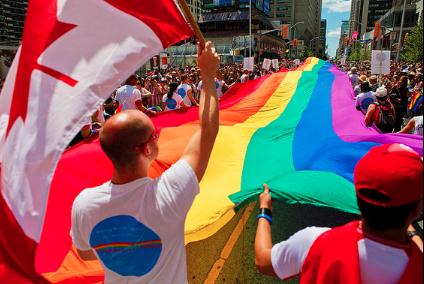
Toronto Pride has been marching down Yonge Street since 1991. The board is now considering a move to Jarvis Street. Credit: Adam Coish (file photo)
Pride Toronto (PT) is considering taking its annual parade down Jarvis Street instead of Yonge Street next year, says executive director Kevin Beaulieu.
Beaulieu says the idea has been suggested in the past and now the board is giving it serious consideration.
“It’s possible,” he says. “It would mean a number of changes to the length of the route. There are some pros and some cons. It’s a more open and wide street. It’s less busy, less commercial . . . Some people like the idea.”
It would be a significant change, Beaulieu says, and consultation with the community would need to happen before any change takes effect. “We would do that early to explain to the community why and give people a chance to express their support or objections.”
The main benefit in moving to Jarvis would be the increase in street size, he says.
“Jarvis is a more open street. It’s less confined. Pride has grown quite big. It’s very large and it takes quite a long time to walk down Yonge Street,” he says. “It would just open things up a little bit more and make it less of a compressed atmosphere.”
Pride first used Yonge Street for the parade in 1991. Previously, the parade route followed Church Street. Prior to that, Lesbian and Gay Pride Day was held in Grange Park in 1982, King’s College Circle in 1983 and Cawthra Park from 1984 to 1986.
“The parade moved around the city a number of times before finding a home on Yonge Street,” says activist and journalist James Dubro, who remembers attending a gay march at Hanlan’s Point in 1971, organized by Toronto Gay Action, which is now considered the first Toronto Pride event.
“Are we [considering a move to Jarvis] for the gay community or the straight community?” Dubro asks.
Gerald Hannon, another long-time queer activist and journalist, says moving the parade to Jarvis takes the march off Toronto’s main street.
“That would certainly take it out of sight,” he says. “We’d be much less visible on Jarvis.”
Scott Dagostino, manager at Glad Day Bookshop on Yonge Street, says there is something symbolic and powerful about marching on Yonge.
“Obviously, Glad Day Bookshop enjoys its long-time perch at the nexus of Toronto Pride,” he says. “But more importantly, watching the queer community take over the city’s longest, most central and arguably most important street has always felt like a victory. Moving to Jarvis would dilute that.
“Then again, given the recent debacle with removing the bike lanes, perhaps Jarvis is more essential than I thought,” he jokes.
Dubro also worries that Yonge Street businesses would object to the loss of tourism dollars that Pride brings in every year.
“I love that it’s on Yonge Street and that there’s all these thousands of people filling the street, because that’s the point,” he says. “Moving it doesn’t grab me as necessary. If something’s not broke, you don’t have to fix it.”

 Why you can trust Xtra
Why you can trust Xtra


